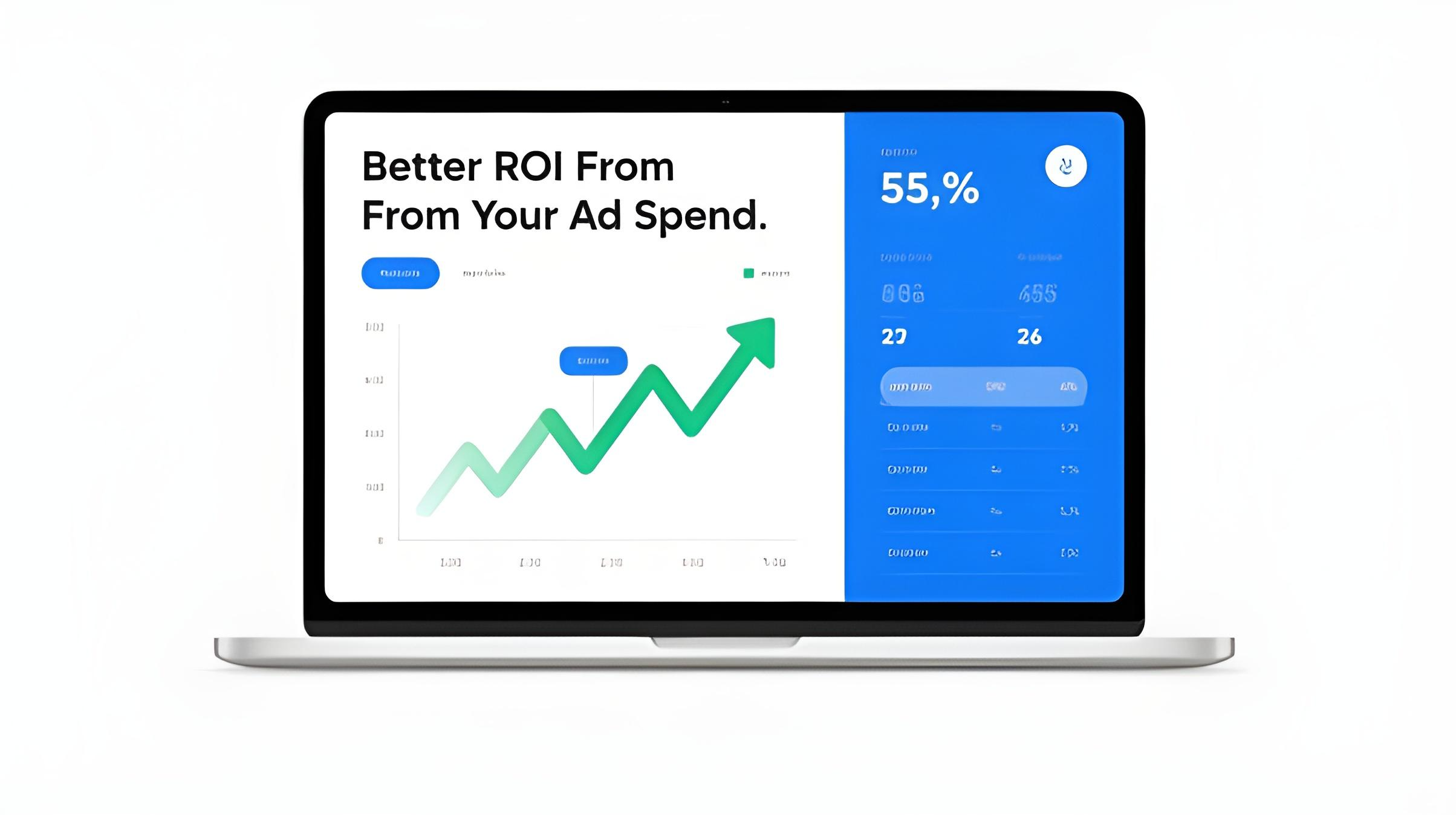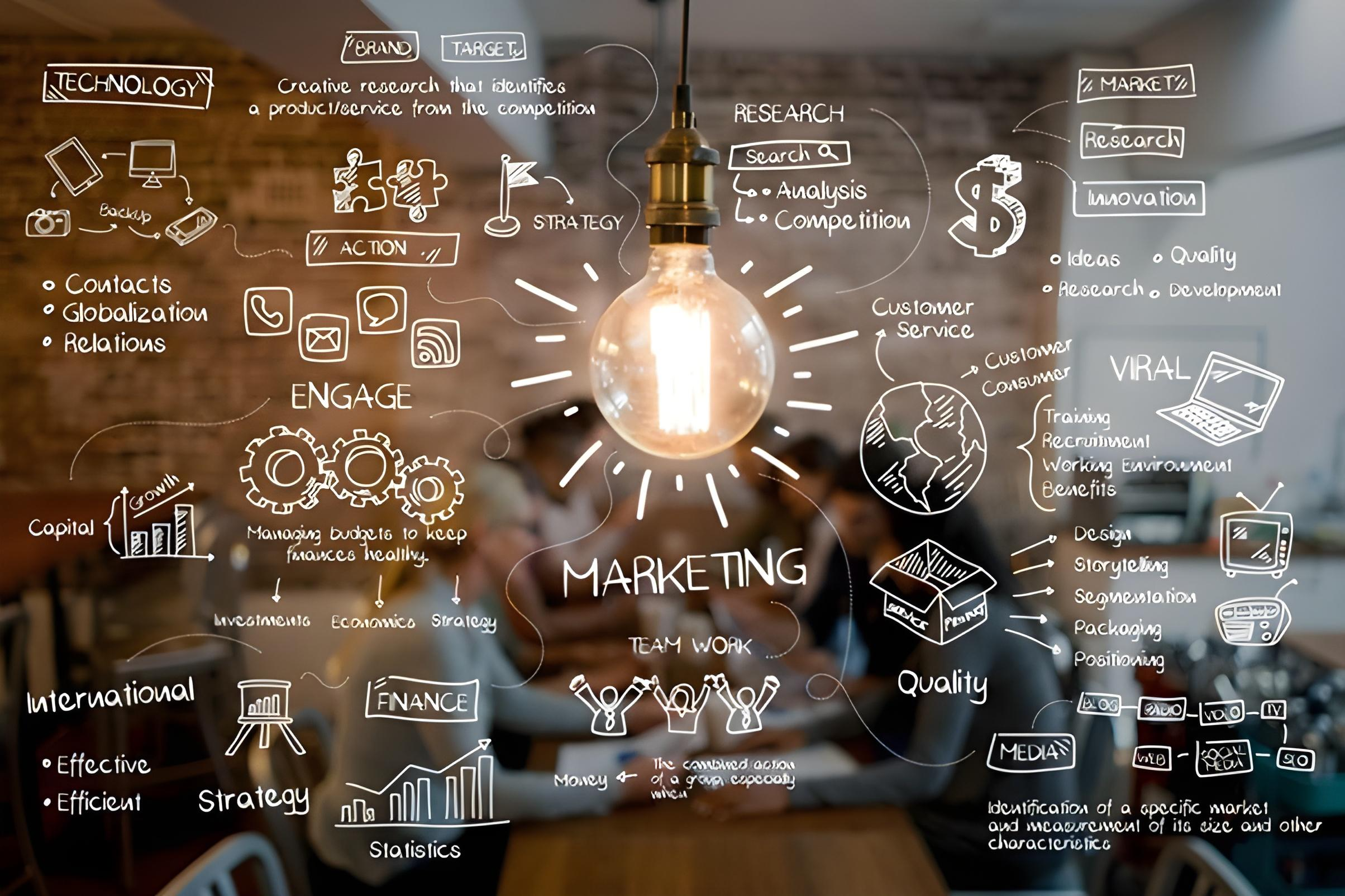AI For Marketing

Unlocking the power of AI for marketing success

Marketing today isn’t just about creativity. It’s about speed, data, and showing up in the right place at the right time. That’s where AI comes in. It’s not just hype. It’s a tool that helps you write faster, target smarter, and make better decisions without stretching your team too thin. If you’re still doing everything manually, you’re already behind. AI is how modern marketers double down on what works and cut out what doesn’t.
What sets AI apart is how quickly it transforms raw data into action. It helps you understand what your audience wants, not just what you assume they want. It finds patterns, pulls out insights, and takes care of repetitive tasks so you can focus on strategy and creative work that actually makes a difference. The brands pulling ahead today are the ones treating AI as a teammate, not just a passing trend.
What is AI for marketing?

AI for marketing refers to the use of advanced technologies like AI marketing tools and AI algorithms to help businesses understand customers better, create content faster, and run smarter campaigns. Rather than relying on gut instinct or handling every task manually, marketers can now use AI-powered marketing solutions to analyse data, predict customer behaviour, and automate repetitive work—whether that’s writing emails, targeting adverts, or personalising web experiences.
The power behind AI-driven tools lies in machine learning, natural language processing, and sentiment analysis. These systems enable teams to make quicker, more informed decisions and adapt in real time. From spotting emerging trends to fine-tuning messaging for a specific target audience, AI supports better outcomes with less manual labour.
Marketers also gain access to AI-driven insights—actionable takeaways pulled from large volumes of data that help refine strategies and boost ROI. Whether you're working on social campaigns, paid ads, or email funnels, the right AI solution can free up time for the creative work that matters most.
In short, AI in marketing gives your team something close to superpowers—sharper targeting, faster turnarounds, and content that actually hits the mark.
The real benefits of using AI in marketing
AI isn’t just a trendy buzzword. It’s a core tool for marketers who want to move faster, work smarter, and stop wasting time on tasks that no longer need to be done by hand. Teams using AI well are seeing better results, without burning out.
Faster, smarter decision-making

One of the biggest advantages of AI is how fast it works. Traditional marketing reports can take days to process and analyse. With AI, you can see what’s working in real time. You don’t have to wait for a post-mortem to fix something. You can tweak a campaign while it’s still running. Even better, AI suggests your next move based on trends it picks up in the data. So instead of reacting, you’re staying ahead of the curve with decisions grounded in real evidence.
Better ROI from your ad spend

When budgets are tight, the last thing you want is to throw money at the wrong platform or message. AI gives you a clear breakdown of what’s performing, who’s engaging, and where your best opportunities are. It shows you which audience segments are most responsive, which channels deliver the strongest results, and how timing affects performance. You’re not just saving money—you’re spending it smarter, like having a digital strategist in your back pocket.
Personalisation that works

People want to feel understood, not lumped into generic groups. AI helps you personalise at scale. It adapts content, product suggestions, and even online experiences to each individual based on what they’ve done, browsed, or bought before. Instead of crafting dozens of emails manually, AI ensures each customer gets a message that feels tailored, without you having to write every version yourself.
Faster content without sacrificing quality

Creating content takes time, but AI makes the process smoother. Need article ideas? AI will scan your audience’s interests and give you a list. Stuck on a headline? It will suggest five. You can use it to draft outlines, polish emails, or get a rough version of a post ready in seconds. Then you take over to give it your voice. This isn’t about cutting corners. It’s about keeping up the pace without burning out your creative team.
Smarter customer relationships

AI is also improving how marketers manage customer relationships. It takes care of repetitive admin like tagging contacts, sorting leads, and tracking engagement. More importantly, it flags when a customer starts losing interest or looks likely to leave. That gives you a window to act and reach out with the right message before the relationship slips away. When your timing is better, so is your retention.
Clearer insights from overwhelming data

Marketing generates more data than most teams can handle. But raw data doesn’t mean much without context. AI turns that chaos into clarity. It filters what matters, spots performance issues in your funnel, and links outcomes to actions so you know exactly what’s driving results. You don’t need a full analytics department. You just need tools that turn complexity into smart, usable insights.
AI for marketing: What creatives should know

As AI becomes more deeply woven into modern marketing, it’s pushing creative teams to re-evaluate how they work. Marketing has always leaned on gut instinct, visual flair, and emotional storytelling—qualities that don’t naturally align with cold data or automation. So it’s no surprise that many creatives are cautious. They’re not rejecting AI, but they are asking: how do you introduce tech into workflows that are built more on feeling than formulas?
The shift is already happening. Large language models and creative AI tools are quietly taking over repetitive, admin-heavy tasks that eat up time but add little value. Writing basic ad copy variations, summarising feedback, sorting campaign responses—these are the kinds of jobs AI is handling well. It’s not about replacing the creative spark. It’s about clearing the clutter so humans can focus on the bigger picture. Chad Johnson, Director of Artificial Intelligence at SADA, points out that marketers are no longer just intrigued by AI’s potential—they’re rolling up their sleeves and finding real, practical uses for it.
AI in marketing is not taking creativity off the table—it’s making space for it to grow. The smartest teams aren’t asking whether AI will take their place; they’re figuring out how it can help them work better, faster, and with more focus on what matters.
1. From hype to practical: where AI Is actually delivering value

The buzz around generative AI is starting to settle. What began as wide-eyed experimentation is now turning into serious conversations about real business problems. Chad Johnson, Director of Artificial Intelligence at SADA, spends his time helping clients figure out how to apply tools like Gemini for Google Workspace and Vertex AI to issues that slow teams down.
Instead of asking, “What can AI do?” more marketers are now asking, “How can it help with the stuff that’s eating up our day?” According to Chad, most of the real traction is happening in three key areas: data triage, data extraction, and decision-making.
Sorting the mess: Smarter data triage
If your inbox or social feeds are overflowing, AI can help clear the clutter. Data triage is about sorting and routing information to the right place, fast. For example, AI can scan replies to your latest email campaign and direct positive responses to sales, complaints to customer service, and feature requests to the product. That means less time manually reviewing messages and more time acting on what matters.
Extracting insights from chaos
Marketers are sitting on a mountain of data—customer reviews, chat transcripts, survey responses—but most of it’s unstructured and hard to analyse. AI can pull out key pieces, like what features customers love or what pain points keep coming up, and turn them into organised tables you can use. Instead of skimming thousands of reviews, you get a clear picture of what’s working and what needs fixing.
Better decisions with less guesswork
AI isn’t just about automating tasks. It’s helping marketers make sharper calls. Agentic AI—where the system acts a bit like an assistant with initiative—can spot trends by season, region, or audience type. It can even help tailor your campaign copy for different segments based on your goals and tone of voice. You set the brief, and the AI delivers options that stay on-brand while saving hours of creative time.
More teams are waking up to the fact that AI’s real power lies beyond flashy images or text generation; it’s in connecting the dots between your CRM, campaigns, and customer feedback, then acting on it faster than you ever could manually. And if you’re already using tools like Gemini, you’ve got a solid foundation to start exploring this shift in a meaningful way.
2. Creativity meets GenAI in Google Workspace

Generative AI is no longer a separate tool sitting on the sidelines. It is now built directly into the platforms that marketing teams already use every day. Gemini for Google Workspace is a clear example. For many marketers, it is the biggest shift in daily workflow since the rise of email. Instead of learning a brand-new system, creatives can tap into AI from within the apps they already know, such as Gmail, Google Docs, and Slides. That seamless integration is a game-changer, especially for teams that rely on fast communication and constant collaboration.
The difference now is scale. Google Workspace has had AI features like predictive text, but Gemini takes things much further. It helps creatives move faster on the tasks that usually slow them down, like writing first drafts, building slide decks, summarising meetings, or pulling ideas together across documents. While the work still needs human judgment, the groundwork is being laid by AI. This frees up time for marketers to focus on refining the message or sharpening the creative.
But this shift is not just about speed. It is also forcing teams to rethink how they approach creativity. With AI now sitting inside the same tools used for brainstorming and execution, new questions are emerging. What part should AI play in idea development? Can it collaborate without watering down the human element? These are the kinds of discussions SADA’s AI experts are having. Because when creativity and AI operate within the same platform, it is no longer just about adding tech. It is about changing how marketing works from the inside out.
3. Start bringing AI into your marketing workflow today

If you're part of a marketing team juggling multiple goals, deadlines, and creative challenges, the idea of adding AI into the mix might feel overwhelming. But you don’t have to wait for a grand plan. You can start applying AI in simple, practical ways that support your current setup. Not sure where to begin? Here are three useful areas where AI can make an immediate difference.
Feed it the right information
AI tools like Gemini rely on large language models trained on vast datasets. But you can make them even more effective by narrowing their focus. Think about which content in your business could help guide the AI’s responses. Maybe it’s the last 12 months of blog articles. Maybe it’s client-facing PDFs tucked away in your Drive.
Data is what fuels your AI engine. And the better prepared your data is, the better your results will be. If you haven’t already, get familiar with the three Vs of big data: volume, velocity, and variety. These will help you assess whether your current data strategy supports meaningful outputs from GenAI.
Some valuable data sources to feed into your AI model include:
- Historic marketing performance and analytics
- Customer profiles and segment data
- Research on your competitors and market trends
- Brand tone of voice, visual identity, and messaging guides
Think of it as briefing a new team member. What would they need to understand your business? Load Gemini with your best content—like your highest converting email, your value proposition, and your customer personas—and ask it to generate fresh material based on those insights.
Focus on automating tasks, not replacing people
Every role is made up of tasks. Some are enjoyable and strategic. Others are repetitive, necessary, but not especially stimulating. For marketers, that might mean churning out headline variations, writing short descriptions, or pulling together images for assets. These jobs can eat into your time fast.
Examples of tasks GenAI can handle for marketers include:
- Building out social media content calendars
- Producing early drafts of newsletters or web copy
- Summarising customer surveys or feedback
- Writing internal updates and meeting recaps
Over time, these tasks pile up and cut into your ability to focus on big-picture work. That’s where AI steps in. Offloading the routine bits gives you more bandwidth to shape the strategy, create higher-value content, or spend more time connecting with your audience.
Think of working with GenAI like having a conversation. It might not nail your tone the first time, but as you adjust your prompts and give better instructions, it becomes easier to get exactly what you’re looking for.
Work across formats with ease
One of the most underrated features of generative AI is its ability to move between formats. You can turn a written document into a presentation or summarise a spreadsheet into a pitch-ready email. This is particularly powerful for marketing teams that juggle words, visuals, data, and presentations on a regular basis.
Instead of getting stuck in handovers between designers, writers, and analysts, AI can support a more collaborative flow. Multimodal tools like Gemini bring these elements together so teams can explore ideas faster and in more formats. This not only reduces delays but can also lead to more unexpected and innovative outcomes.
4. There’s never been a more accessible time to explore AI in marketing

According to SADA’s Associate CTO for AI and Machine Learning, Simon Margolis, the barriers to using generative AI in creative roles have never been lower. “Right now is the easiest time in history to start experimenting with powerful GenAI tools,” he explains. “As long as you can put your ideas into words, you’ve already got the core skill needed to create with AI—whether it’s for blog articles, pitch decks, long-form content, or campaign visuals. The key is identifying those simple, high-impact uses that just make sense and don’t require any technical background.”
At SADA, the AI and ML teams are actively working to embed GenAI more deeply into marketing operations. From automated content development to real-time sentiment tracking, these tools are unlocking new efficiencies and insights for marketing professionals.
If you’re ready to explore what AI can do for your team, SADA offers a free initial consultation through its AI Journey Accelerator. This programme includes step-by-step support from SADA specialists to help you design and implement an AI-driven marketing strategy that delivers measurable results.
Best practices for using AI in marketing

Start with clean, reliable data
The strength of any AI system depends heavily on the quality of the data it’s built on. No matter how sophisticated the tool is, if it’s trained on messy, outdated, or biased information, the results will be unreliable. Before rolling out AI in your digital marketing efforts, it’s essential to review your datasets. Many companies begin by cleaning and standardising their data to minimise errors and improve consistency across channels, which also helps ensure accurate data analytics and campaign performance tracking later down the line.
Build a strong data foundation
For AI to function effectively, it needs to work with data that flows freely across systems. This means ensuring integration between your CRM, website analytics, sales tools, and social media management platforms. Investing in cloud infrastructure and real-time data pipelines allows teams to gather actionable insights across touchpoints—from social media marketing to email marketing campaigns and Google Ads. These systems support content personalisation, enabling better engagement based on user behaviour and search queries.
Train AI with purpose-built data
Much like onboarding a new team member, AI needs the right training to perform well. If your goal is to develop an AI that writes copy, manages ad content, or curates social media posts, it has to be trained using relevant, targeted examples. This is especially true for industries where tone and brand voice matter. Leading brands are building tailored datasets from previous ad creatives, ad formats, and even ad accounts, often using customer interactions and historical competitor analysis to train their tools effectively.
Follow clear data governance practices
When AI handles personal or sensitive customer data, following the rules is non-negotiable. Businesses must comply with laws such as GDPR and ensure data privacy throughout the process. It’s also important to communicate clearly with users about how their data is used in things like content creation, personalised emails, or tailored landing pages. Solid governance not only protects your brand but also strengthens trust, especially in areas like search engine targeting or content optimisation.
Review and refine AI performance
Setting clear goals before introducing AI makes it easier to track outcomes like creative insights, click-through rates, or overall competitive analysis. As your marketing programme evolves, it’s crucial to monitor tools against KPIs—whether that’s performance of web pages, rankings of top-ranking pages, or how well new content aligns with keyword research. This feedback loop ensures your AI continues to drive impact and adapt to changing customer needs.
Equip your team with new skills
The introduction of AI into marketing often reshapes day-to-day roles. Team members may shift from manual content work to strategic tasks like content planning or reviewing insights into customer behaviour. By offering training and upskilling opportunities, you help staff stay ahead—whether they’re optimising social media efforts, experimenting with tools that generate videos, or creating dynamic email marketing campaigns. Understanding how and when to use AI ensures a balance between automation and human creativity.
A practical guide to adding AI to your marketing strategy

Bringing artificial intelligence into your marketing operations doesn’t have to be complicated. It could be as straightforward as using AI-powered tools to streamline repetitive tasks, or as involved as creating custom solutions that work with your internal data. Whatever route you take, the seven steps below can help you build a solid foundation for using AI effectively in your marketing efforts.
Step 1: Define your objectives
Start by identifying the problems you want AI to solve. Look at pain points in your current campaigns or areas where your team is spending too much time. Setting clear goals and aligning with stakeholders, such as your chief marketing officer or senior strategists, will make it easier to select the right AI tools and set meaningful KPIs to measure success. This early alignment is crucial for solid strategic decision-making.
Step 2: Bring in the right expertise
AI and machine learning usually fall outside the typical scope of most marketing departments. You’ll likely need data specialists, engineers, or AI consultants to get things moving. Some companies prefer building in-house capabilities, while others hire third-party partners. For small business owners, outsourcing may offer a cost-effective way to access technical know-how without a large upfront investment.
Step 3: Stay compliant with data laws
One major challenge when using AI for marketing is managing customer data responsibly. You’ll need to ensure any personal information used in training or automation complies with local and international privacy laws. This may involve updating security measures or limiting access within your sales team or marketing unit. Transparency in data usage also strengthens customer engagement and builds long-term trust.
Step 4: Validate the quality of your data
AI is only as effective as the data it’s given. If your data is outdated or off-target, the insights you get will fall short. Clean, high-quality data—especially when it reflects your real target audience—is critical for better predictions and content personalisation. Getting this part right sets you up for more consistent campaign wins and supports smarter marketing functions across the board.
Step 5: Select the best-fit AI solution
With your objectives clear and data in place, choosing the right tool becomes far easier. Look for platforms that align with your actual marketing needs, like customer segmentation, automation, or content creation. Performance marketers might seek tools that plug directly into paid media platforms, while others may prefer AI systems that complement their brand identity and voice. The key is to pick something that fits your strategy, not just what’s trendy.
Step 6: Implement and adapt
Once you've selected your AI solution, it’s time to roll it out. This could be as simple as uploading a dataset into a plug-and-play tool, or as complex as deploying features across multiple online platforms and touchpoints. Whatever the case, successful implementation depends heavily on change management. You’ll need to guide your team, reshaping workflows to blend automation with human creativity and judgment where it still matters.
Step 7: Track performance and refine
AI tools aren't "set and forget." You'll need to measure their performance against your defined KPIs and adapt as things evolve. Feeding updated data into the system helps keep outputs relevant and accurate. It’s also worth checking in on how employees are engaging with the tech—some tools may enhance productivity, while others might need tweaking to integrate fully into your sales engagement platform or content process. And don’t forget, there are still areas where human writers will outperform machines—knowing when to switch between the two can be a game-changer.
FAQ
AI is playing a big role in modern marketing by helping businesses understand their customers better and make smarter decisions. It works by collecting data, analysing it with machine learning, and using tools like natural language processing to uncover insights. Marketers then use this info to personalise content, automate tasks, and improve campaign performance.
LET'S TALK
Our expert teams of consultants, architects, and solutions engineers are ready to help with your bold ambitions, provide you with more information on our services, and answer your technical questions. Contact us today to get started.

